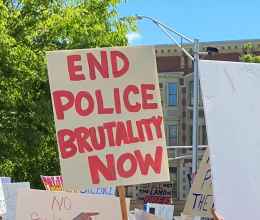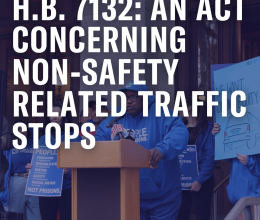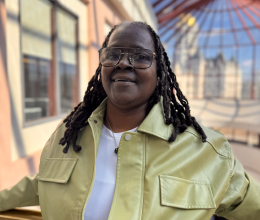With Connecticut’s prison population at the lowest it’s been in decades, Governor Ned Lamont last month announced that the state plans to close Radgowski Correctional Center in Montville by the end of 2021. According to Lamont, the approximately 100 people whom the state imprisons at Radgowski will be transferred elsewhere in the state, and none of the approximately 100 people who the state employs there will lose their jobs.
If Radgowski closes, it will be the sixth prison to close in Connecticut since 2010. During Governor Dan Malloy’s administration, Connecticut closed four prisons and one prison annex, and Radgowski would mark the second prison closure during Lamont’s time in office – after decades of advocacy from incarcerated people, formerly incarcerated people, their loved ones, and advocates including the ACLU, Connecticut closed the notorious Northern Correctional Institution this summer. In the budget passed by the legislature and approved by Lamont, a third yet-to-be-named prison is also slated for closure this year.
Prison closures are a good thing. The human and financial costs of incarceration are astronomical, and the systemic racism of incarceration means these costs are especially high for Black and Latinx people. Connecticut shouldn’t invest more in the cruel, failed system of imprisonment and should instead value residents’ lives – especially Black and Latinx residents’ – by putting its resources into healthcare, education, jobs, infrastructure, and other programs and services that create real community safety by making sure people can support themselves and their families.
But closure is just the first, minimum step. Any time Connecticut closes a prison, the state must also do these three things:
1. The state must actually close the prison, thoughtfully and on time.
An announcement from the Governor that the state will close a prison isn’t the same thing as closing the prison itself. When the state decides to close a prison, it has a responsibility to safeguard the health, dignity, and rights of people incarcerated there. This means keeping any transfers within Connecticut, not putting people in worse conditions, and listening to incarcerated people and their loved ones about their needs. Prison closures must have deadlines, so there is accountability for government officials to get it done and transparency for incarcerated people and their loved ones about what to expect.
2. The state must demolish the building.
As long as a prison building remains in place, there is a danger the state will decide to use it for incarceration or another dangerous purpose. In fact, Governor Lamont recently proposed using the shuttered Connecticut Juvenile Training School (CJTS) to house migrant children, a plan that fell through because the federal government turned down the offer. CJTS was modeled after an adult prison in Ohio and had windows so small that federal officials barred the state from using 95 of 200 cells even for incarceration, making it deeply disturbing that Lamont would consider putting vulnerable children there again. Connecticut must raze prison buildings once they’re closed.
For one, prison buildings are unhealthy places, often by design. Nationwide, researchers have found that states have built hundreds of prisons built on and adjacent to toxic waste sites, and the dangers of outdated ventilation, sanitation, and materials used to build prisons are well-documented. Closer to home, people in Connecticut prisons have documented problems with raw sewage in drinking water and asbestos and sewage backing up into cells. Sewage leaks at Osborn Correctional in the early 2000s cause so much pollution that part of the surrounding town became a designated “superfund” toxic site. By architectural design, prison buildings are also built for punishment and cruelty. Northern Correctional Institution, which visitors and incarcerated people have described as tomb-like, was purposefully built to disorient people.
No one should ever forget that there is also no repurposing cruelty. People have suffered and died in prisons. In Connecticut, systemic racism means the majority of people who suffer and die in prison are Black and Latinx. For people who have been incarcerated and their loved ones, prison buildings are symbols that bring up many complex emotion.
One of us, senior policy organizer Anderson Curtis, was discharged from Radgowski 14 years ago. For him, those complex emotions are very real and palpable. Since coming home, Anderson says, “Many days, my choices were made not by me, but by the collateral consequences of my criminal record. Those consequences were sometimes seen, but mostly I felt them when I hit another wall barring me from employment and housing. People don’t need to see the symbol of the state putting more money into turning a prison into something else. People do need livable wage jobs, affordable housing, and real money put into helping people survive after incarceration. People need hope, not perpetual punishment from exclusionary policies which just extend the prison walls.”
"People need hope, not perpetual punishment from exclusionary policies which just extend the prison walls.”
Like Anderson pointed out, repurposing closed prison buildings would cost more money that Connecticut should better spend elsewhere. Just because the state has sunk money into the failure of a prison does not mean the state should sink even more into repurposing shuttered monuments to incarceration.
3. The state must reallocate any money saved into programs and services for people most harmed by incarceration, especially in Black and Latinx communities.
Incarceration is expensive, in dollars and human cost. To really make people safe, and to prevent incarceration from going back up again, Connecticut has to invest in the things that really help people thrive. Because when a prison closes, the state should be doing everything to make sure the number of people incarcerated keeps going down, and that more prisons empty as a result.
In the past decade, Connecticut has budgeted more than $8 billion for the Department of Correction alone and millions more on the prosecution and policing that feed into incarceration (from FY 2012 to FY 2021, Connecticut’s budgeted amount for the DOC totals $8,172,610,000). Those billions of dollars could have instead gone to things that, unlike incarceration, are proven to make our communities stronger and safer, such as healthcare, jobs, schools, mental healthcare, addiction services, and infrastructure.
Investments in incarceration also most often come at the expense of real investments in Black and Latinx communities. While majority Black and Latinx cities like Bridgeport, Hartford, New Haven, Waterbury, and New Britain struggle to secure funding for even basic needs like health services, food security, and neighborhood schools, the state has poured money especially into incarcerating and policing those towns’ residents, and into incarcerating and policing Black and Latinx people throughout the state.
Breaking the cycle of incarceration, which can trap people in the criminal legal system for life after a conviction, means putting money into programs and services for people most harmed by incarceration. Groups like the ACLU of Connecticut, SEIU 1199 New England, Connecticut Coalition to End Homelessness, and Yale Transitions Clinic have all spoken out about programs and services where money saved from prison closures could go instead – to mobile mental health crisis units staffed by healthcare workers, peer-led healthcare clinics and outreach run by formerly incarcerated people, Clean Slate implementation, housing for people reentering society after incarceration, and more.
When a prison closes, the door has to open to a better path forward. Connecticut has done the right thing by reducing incarceration and closing prisons, and our state needs to make sure it stays on that path by making smart choices to invest in people, not prisons.






